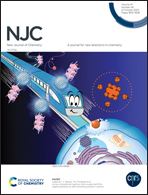Efficient lead sorption by ammonium phosphomolybdate: experimental and density functional theory (DFT) studies
Abstract
Ammonium phosphomolybdate [APM, (NH4)3PMo12O40·xH2O] is a versatile inorganic compound having diverse applications in the catalysis and dielectrics fields and high adsorption capacity for large metal cations due to its negatively charged cage-like structure with hollow cavities. In this study, APM was synthesized via a precipitation method and several parameters, such as the solid-to-liquid ratio (S : L), pH value, initial metal concentrations, adsorption isotherms, temperature effect, adsorption kinetics, shaking time, and interference of multiple ions were investigated for the effective removal of Pb2+ ions from aqueous media. The experimental results revealed that 100% of the Pb2+ ions were successfully adsorbed at the surface of APM at pH values from 2 to 6. Under the optimized conditions, the maximum adsorption capacity of 951.65 mg g−1 for Pb2+ ions on the APM was obtained at an S : L ratio of 0.1 g L−1 based on the Freundlich adsorption model. The adsorption equilibrium was achieved within an hour. The presence of alkali and alkaline metal ions did not interfere with Pb2+ adsorption, indicating the high selectivity toward Pb2+ ions. The Pb2+ ion adsorption mechanism was determined using DFT calculations, which revealed that Pb2+ is likely to interact directly with the 4 O atoms of the H-quadrate site, which hints towards the formation of a PbMoO4 complex, in reasonable agreement with the experimental findings. It was further confirmed using DFT that the exchange of Pb2+ ions with NH4+ ions is energetically favorable. Because of its high removal efficiency, selectivity, easy synthesis and handling, cost-effectiveness, fast kinetics, high stability in acidic pH and effective adsorption of Pb2+ ions even in the presence of alkali and alkaline metal ions, the APM sorbent can potentially be used to remove toxic Pb2+ ions from aqueous solutions for commercial applications.



 Please wait while we load your content...
Please wait while we load your content...